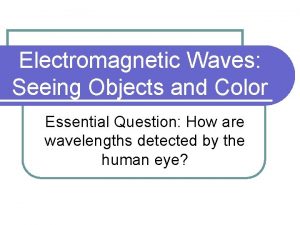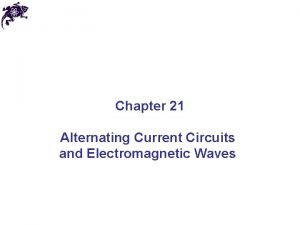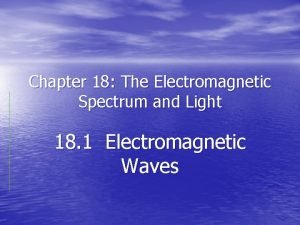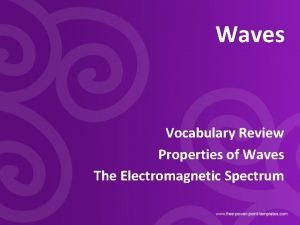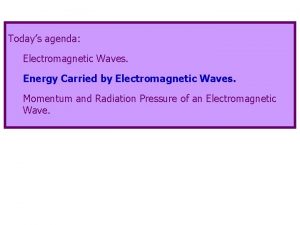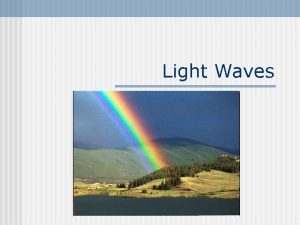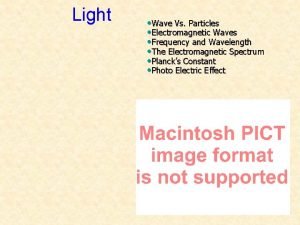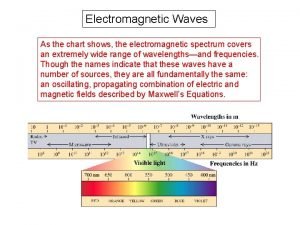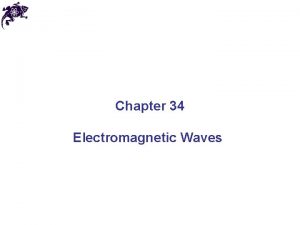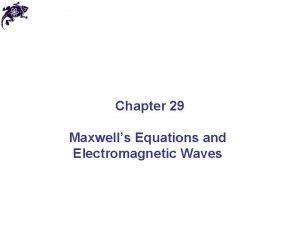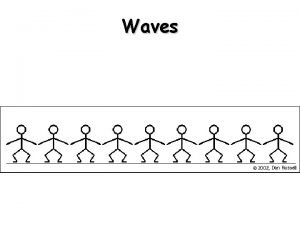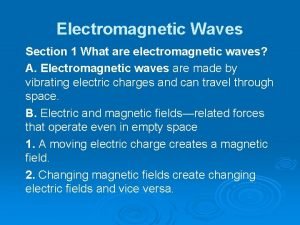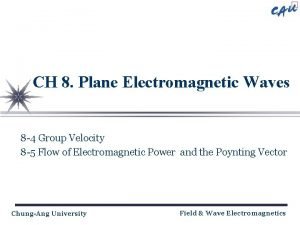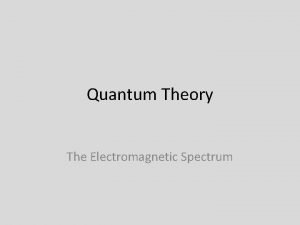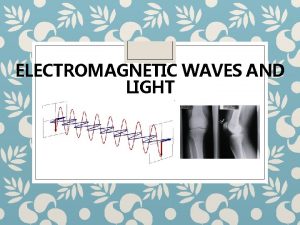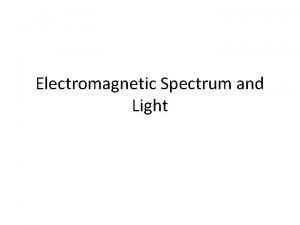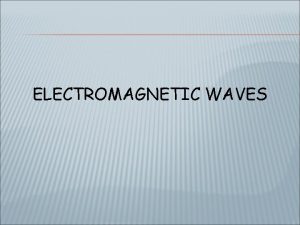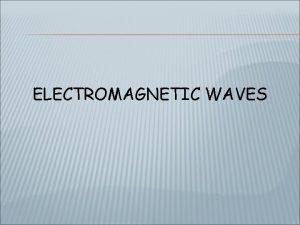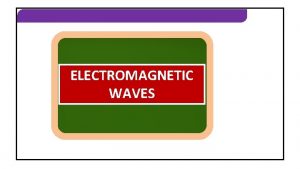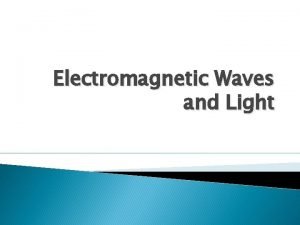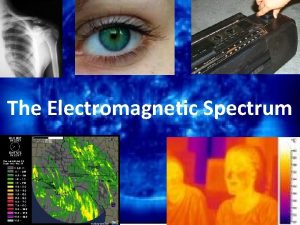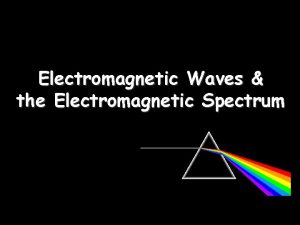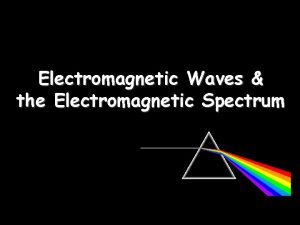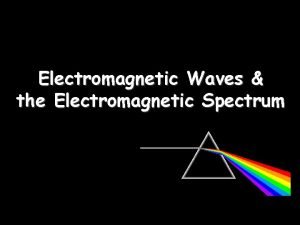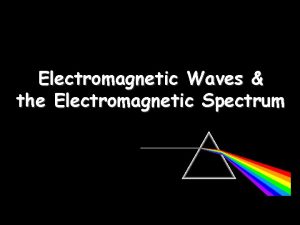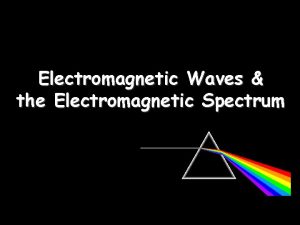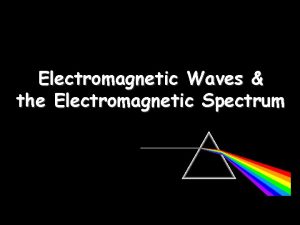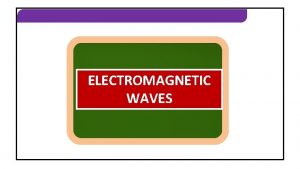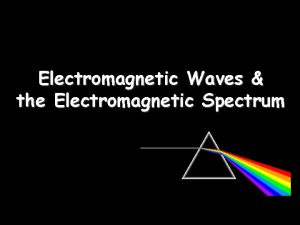Light and Electromagnetic Waves Electromagnetic Waves Consist of




























- Slides: 28

Light and Electromagnetic Waves

Electromagnetic Waves Consist of two transverse waves that are at right angles to one another Electric Field Magnetic Field

Electromagnetic Waves Do not need a medium to transfer energy Will travel through space! space

The Electromagnetic Spectrum EM waves are arranged according to wavelength and frequency Long wavelengths have Low frequencies Short wavelengths have High frequencies

The Electromagnetic Spectrum

The Electromagnetic Spectrum

Radio Waves Lowest Frequency, Lowest Energy Waves Modulation: Variation in either frequency or amplitude of a wave

Microwaves Higher frequency radio wave Microwave ovens – microwaves penetrate food and vibrate water & fat molecules to produce thermal energy Also used in cell phones and radar (speed gun and weather forecasting. Doppler Radar) Radar

Microwaves

Infrared Can not see, but felt as Heat Depends on temperature of object 50% of sun’s rays are infrared Infrared Lamps and Cameras (thermographs)

Visible Light Very small part of the spectrum we can see called visible light. Wave length (from 400 nm to 700 nm) Almost ½ the sun’s rays are in visible light Required for photosynthesis in plants

Ultraviolet Frequencies just higher than visible light Energy from these rays can kill living cells (good & bad) Used in food preparation and storage Ozone in the atmosphere and Melanin in our skin help protect us from UV rays.

Ultraviolet How are we destroying the ozone layer?

X-Rays Greater energy than UV rays. Shorter wave lengths Can pass through less dense material (skin tissue) tissue and is absorbed by more dense material (bone) bone

Gamma waves Highest frequencies & shortest wavelengths Highest Energy, can pass through skin and bones Radioactive materials & nuclear explosions emit gamma rays Can penetrate up to 3 meters of concrete!

Summary

More on Light

Luminous vs. Illuminated Luminous: Anything that gives off its own light. Produces light. Ex. sun, stars, light bulbs, candles, fire

Luminous vs. Illuminated: Anything seen because it is lit up by another luminous object. Reflects light. Ex. moon, paper, person

Luminous Lights (Gives off its own light) Incandescent- from heated objects, exa. standard light bulb, fire Fluorescent- gas under pressure; cool to the touch Neon- neon gas under pressure; cool

Materials and Light Transparent: Most light passes through the material Translucent: Scatters light; Can see light coming through, but not clearly Opaque: Absorbs and/or reflects all light that hits it; Cannot be seen through

Transparent, Translucent, or Opaque

Transparent, Translucent, or Opaque Transparent

Transparent, Translucent, or Opaque

Transparent, Translucent, or Opaque Translucent

Transparent, Translucent, or Opaque

Transparent, Translucent, or Opaque

Behavior of Light Einstein discovered light has a dual nature. Light has properties of a wave, (Can travel through vacuum of space. ) It can also behave as a particle, (Can bounce off other particles. ) Particles of light are called
 Sound waves are electromagnetic waves. true false
Sound waves are electromagnetic waves. true false Example of mechanical wave
Example of mechanical wave Characteristics of mechanical waves
Characteristics of mechanical waves Similarities of mechanical and electromagnetic waves
Similarities of mechanical and electromagnetic waves Mechanical waves and electromagnetic waves similarities
Mechanical waves and electromagnetic waves similarities Similarities of mechanical and electromagnetic waves
Similarities of mechanical and electromagnetic waves Mechanical and electromagnetic waves
Mechanical and electromagnetic waves Mechanical vs electromagnetic
Mechanical vs electromagnetic Light light light chapter 23
Light light light chapter 23 Into the light chapter 22
Into the light chapter 22 Chapter 22
Chapter 22 Electromagnetic waves: seeing objects and color
Electromagnetic waves: seeing objects and color Alternating current circuits and electromagnetic waves
Alternating current circuits and electromagnetic waves Compare and contrast p waves and s waves using venn diagram
Compare and contrast p waves and s waves using venn diagram Chapter 18 the electromagnetic spectrum and light
Chapter 18 the electromagnetic spectrum and light Radio microwave infrared
Radio microwave infrared Electromagnetic waves vocabulary
Electromagnetic waves vocabulary Energy density of electromagnetic wave
Energy density of electromagnetic wave Electromagnetic waves characteristics
Electromagnetic waves characteristics Electromagnetic waves frequency
Electromagnetic waves frequency Electromagnetic wave carry
Electromagnetic wave carry Radiation powerpoint template free
Radiation powerpoint template free Energy density of electromagnetic waves
Energy density of electromagnetic waves Electromagnetic spectrum equation
Electromagnetic spectrum equation Electromagnetic waves def
Electromagnetic waves def Emona durmati lyrics
Emona durmati lyrics Section 1 what are electromagnetic waves
Section 1 what are electromagnetic waves Power of an electromagnetic wave
Power of an electromagnetic wave Conclusion of electromagnetic waves
Conclusion of electromagnetic waves











